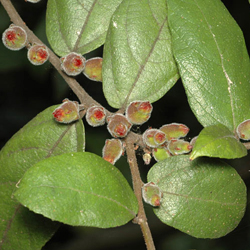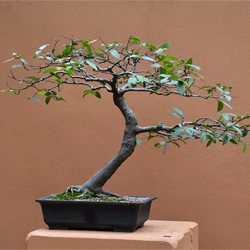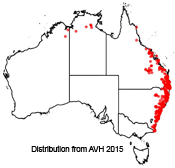Ficus coronata
 |
 Ficus coronata plants have adapted to bonsai cultivation |
Sandpaper Fig, Creek Sandpaper Fig
The genus Ficus contains about 850 species (42 in Australia) of varying growth habit, including vines and epiphytes as well as woody trees, and is in the family Moraceae. Ficus coronata, more commonly known as the ‘Sandpaper Fig’, is a species endemic to mainland Australia. It occurs mainly in eastern Qld and NSW, and is rare in NT and Vic. It is found in a wide range of habitats, including gullies (particularly wet ones), creeks, rainforests, open country, and occasionally in sheltered rocky areas.
This particular fig species forms a medium sized tree of up to 15m tall. It has rough, densely hairy branches and leaves, the latter being reminiscent of sandpaper. As with all Ficus species, F. coronata produces an inverted inflorescence called a syconium. This is a specialised structure that in the case of most figs, can only be fertilised, and thereby ripened, by the pollinating actions of a particular co-dependant species of fig wasp. This fruiting structure is borne on the trunk of the tree, as well as on the axils of the leaves, and measures 20mm long with a 1cm diameter. It is green when unfertilised, darkening to a purple/black when mature. Fruits ripen from January to June.
Ficus coronata is generally a rather hardy species, tolerating colder climates, poor soils, and poor light conditions. It does not, however, tolerate frosts very well, particularly when quite young. The best growing conditions would include plenty of light, space and moisture, in warmer climates free from frosts.
This species will tolerate a heavy pruning, and so can readily be shaped or hedged. It can also have a weeping growth habit, which could provide a good canopy shade in the backyard – for plants and humans alike. Cut material does weep a milky latex material, however, that can cause irritation. Be aware that the aggressive root system characteristic of Ficus species can cause issues with plumbing, concrete paths and structural foundations, and thus should be planted well away from houses and buried facilities. Larger backyards, or more rural environments would be most recommended for in-ground planting.
If your area is prone to frosts, and/or you have limited space, this species would also make an excellent bonsai or small indoor potted tree because of its hardiness and tolerance to neglect and poor conditions. It will thrive, however, if given plenty of love, light and moisture.
Propagation of Ficus coronata can be achieved by the planting of fresh seeds, and also from cuttings taken from the growing tip of a live plant. This species can be purchased as a seedling from many nurseries, particularly those that specialise in Australian natives, local or otherwise.
All in all, this species is an excellent choice for the amateur gardener, whether indoor or outdoor (provided you have the space). It is low maintenance and hardy (and thus hard to kill), produces edible and tasty fruit—attractive to humans and birds alike—and has quirky, texturally interesting leaves.
Jessica Gardner, Botanical Intern 2015
Name meaning: Ficus coronataFicus - from the Latin ficus, meaning “edible fruit” coronata - from the Latin coronatus, meaning “crowned”, referring to the crown of bristles at the tip of the fig |
References:
AUSECO (2009) Fig Trees, AUSECO. Available at http://www.auseco.com.au/index.asp?pagename=eco+updates+fig+trees [Accessed 17 February 2015]
Chew, W. (1989), Ficus coronata, Flora of Australia Vol. 3. Available at http://www.anbg.gov.au/abrs/online-resources/flora/ [Accessed 16 February 2015]
Harden, G.J. (1990) Ficus coronata Spin, in PlantNET - The Plant Information Network System of The Royal Botanic Gardens and Domain Trust, Sydney, Australia (version 2.0). http://plantnet.rbgsyd.nsw.gov.au [Accessed 26 January 2015]
The Royal Botanic Gardens and Domain Trust, (unknown yr), Ficus coronata, The Royal Botanic Gardens and Domain Trust. Available at http://www.rbgsyd.nsw.gov.au/education/Resources/bush_foods/Ficus_coronata [Accessed 26 January 2015]
Wrigley, J.W. & Fagg, M. (2013) Australian Native Plants: Cultivation, Use in Landscaping and Propagation, 6th ed., Reed New Holland, Australia.
![An Australian Government Initiative [logo]](/images/austgovt_brown_90px.gif)


